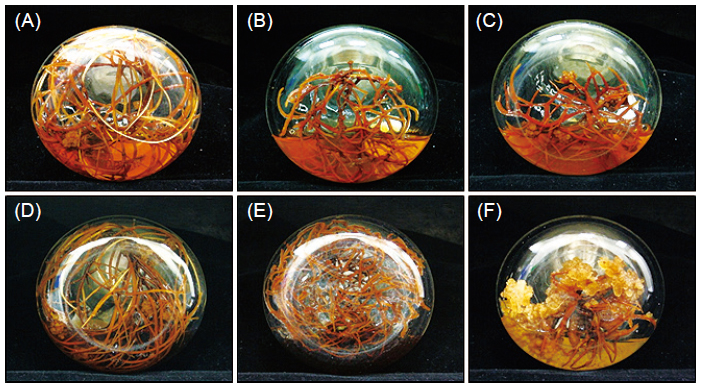All issues

Author:Chi-Ni Hsia, Chin-Yi Tsao, Tzu-Ying Wu, and Uei-Chern Chen*
Abstract:
Salvia miltiorrhiza Bunge, a perennial herb of Labiatae Family, has been used to cure cardiology disease in traditional Chinese medicine for long history. Polyploidy hairy roots containing higher concentration of secondary metabolites than its diploidy are considered as better explants for in vitro production of valuable secondary metabolites. The objective of this study was to establish a selection strategy on tanshinone production of tetraploidy hairy root lines (4N lines) which were induced from the diploid hairy root line (2N line) by colchicine treatment. Three consecutive cultures in solid medium were first conducted on 103 lines of 4N. Among them, 32 lines with the highest tanshinone production were selected for another 3 consecutive liquid medium culture. Meanwhile, two 4N lines and the 2N line were used to conduct the time course culture in liquid medium for 12 wk span. Screening results from solid cultures showed that the average biomass of 103 lines of 4N was only counted 67.2% of the 2N line. However, average total tanshinone contents and productivity of 4N lines were counted 4.66 times and 3.29 times higher than that of the 2N line, respectively. Composition ratios of cryptotanshinone, tanshinone I, and tanshinone IIA contents on 4N lines and 2N line were compared. It was found ratio of cryptotanshinone increasing the most in contrast decreasing ratios of tanshinone I and tanshinone IIA. The ten best lines of 4N selected from solid medium on production of tanshinones were found having only 2 lines remaining in the best ten after liquid medium selection. In order not to miss elite lines, lower selection strength was recommended in the stage of solid culture on 4N lines. Results of time course culture showed that lagging growth of 4N lines than that of 2N line. Moreover, two 4N lines had slightly different growth rates. The highest tanshinone contents were found after 8 wk of culture on 4N lines which was much earlier than that of 12 wk of culture on 2N line. In conclusion, although 4N lines have lower biomass than that of the 2N line, 4N lines have higher tanshinone contents and shorter culture period on tanshinone accumulation which would provide better efficacy on tanshinone production than that of 2N lines. It is thought that selection of elite 4N lines will provide a good foundation for in vitro production secondary metabolites.
Key words:Salvia miltiorrhiza Bunge, Hairy root, Polyploidy, Tanshinone, In vitro culture
Download:![]() PDF Links
PDF Links
- 1. Development of Tractor-Mounted Seedling Transplanter for Sweet Potato
- 2. Synergistic Effect of Additional Gas on the Toxicity of Phosphine to Sitophilus oryzae and Sitophilus zeamais (Coleoptera: Dryophthoridae)
- 3. Effects of Temperature and Solar Radiation on Growth Traits and Plant Elements in Purple Leafy Sweet Potato
 Submit your manuscript
Submit your manuscript
 Guide for authors
Guide for authors